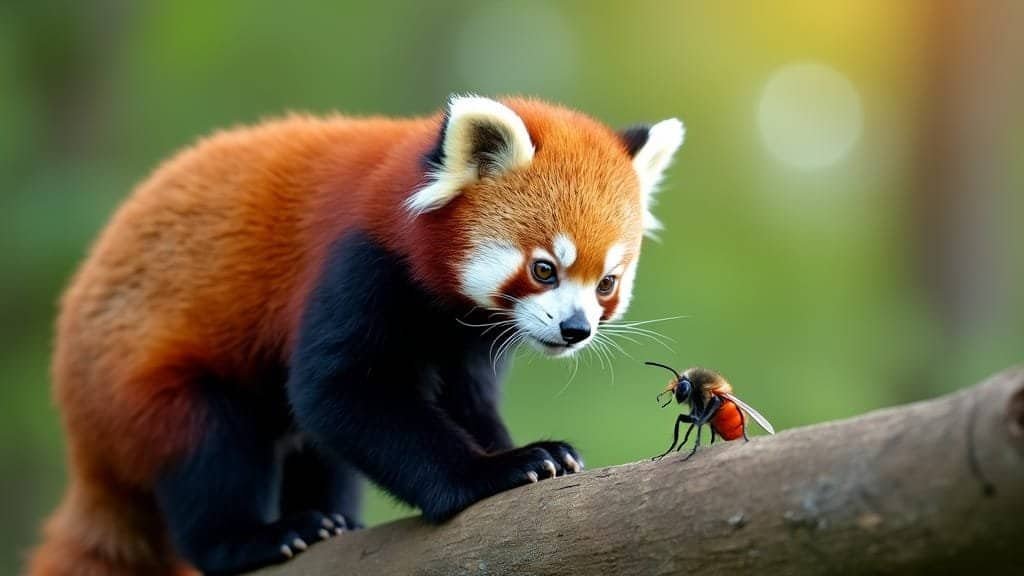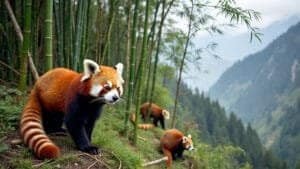Introduction
Red pandas, although primarily known for their bamboo diet and charming appearance, play an important role in maintaining the ecosystems they inhabit. By foraging on bamboo and other vegetation, red pandas influence the health and structure of their forest habitats, which in turn impacts insect populations
Their activities help create and maintain a balanced ecosystem, indirectly regulating insect populations by fostering plant diversity and supporting healthy bamboo forests
This article explores how red pandas contribute to the regulation of insect populations in their ecosystems, focusing on their role in forest health, biodiversity, and ecosystem balance
Red Panda Feeding Behavior and Its Indirect Impact on Insects
Red pandas play an indirect but significant role in regulating insect populations through their feeding behavior, primarily by maintaining the health of bamboo forests
By consuming bamboo and other vegetation, red pandas influence the structure and diversity of their habitats, creating conditions that affect insect communities
Their foraging patterns help control bamboo growth, promote plant diversity, and shape the forest floor environment, all of which impact insect populations in various ways
How Bamboo Consumption Influences Forest Floor Insects
Red pandas feed primarily on bamboo, which makes up about 85-95% of their diet. This heavy reliance on bamboo helps regulate the growth of bamboo forests, preventing overgrowth and promoting healthy forest dynamics
By feeding on bamboo shoots and leaves, red pandas create gaps in the bamboo canopy, allowing sunlight to reach the forest floor. This increased sunlight fosters the growth of other plant species, creating a more diverse and complex understory
The understory of a forest plays a critical role in supporting insect populations, as many insects rely on a mix of plants for food, shelter, and breeding grounds. When red pandas manage bamboo growth through their feeding behavior, they indirectly support a more diverse and balanced plant community, which in turn supports a variety of insect species
For example, certain insects thrive in the leaf litter created by the shedding of bamboo leaves, while others rely on the presence of different plant species that emerge due to increased light penetration
Research by Wei et al. (1999) shows that red pandas’ bamboo consumption contributes to the overall health of forest ecosystems, which benefits insect populations by creating a more complex habitat structure that supports insect biodiversity
The Role of Red Pandas in Controlling Bamboo Overgrowth
Without natural consumers like red pandas, bamboo forests have the potential to grow unchecked, leading to monocultures where bamboo dominates the landscape and outcompetes other plant species
This lack of plant diversity can negatively affect insect populations, as many insects depend on a variety of plants for their survival. When bamboo overgrows, it reduces the availability of other plants that serve as food sources and habitat for insects
By controlling bamboo overgrowth, red pandas help maintain a balance between bamboo and other vegetation. This balance is crucial for sustaining insect populations that rely on a diverse range of plant species
Red pandas’ selective feeding on bamboo shoots and young leaves keeps bamboo growth in check, ensuring that other plants have the space and resources to grow. This, in turn, supports a wider range of insects that rely on the diversity of the forest ecosystem
Studies by Yonzon and Hunter (1991) emphasize the importance of red pandas in maintaining the balance of bamboo and other plant species in their habitat. The research found that areas with active red panda populations had greater plant diversity and, consequently, more robust insect populations
Red Panda Foraging and the Creation of Insect Microhabitats
Red pandas’ foraging behavior also helps create microhabitats that are beneficial for insects
As red pandas move through the forest, feeding on bamboo and other vegetation, they disturb the forest floor, breaking up the dense layers of bamboo leaves and stems
This disturbance creates small openings in the forest floor, where insects such as beetles, ants, and other invertebrates can thrive. These microhabitats provide insects with shelter, food sources, and breeding grounds, supporting the survival of various insect species
Additionally, the leaf litter and plant debris left behind by red panda foraging creates a nutrient-rich environment for soil-dwelling insects and other invertebrates, which play an essential role in decomposing organic matter and recycling nutrients back into the ecosystem
Research by Pradhan et al. (2001) suggests that red pandas’ foraging activities contribute to the overall health of the forest floor ecosystem, providing critical habitats for insects and promoting biodiversity
How Red Pandas Help Maintain Bamboo Forest Health
Red pandas play a crucial role in maintaining the health of bamboo forests, which has significant downstream effects on insect populations. By keeping bamboo growth in check and promoting plant diversity, red pandas help create a balanced forest ecosystem that supports a wide range of species
Healthy bamboo forests not only provide shelter and food for insects but also create an environment where different plant species can thrive, further supporting insect biodiversity
Red Pandas’ Role in Promoting Plant and Insect Biodiversity
Bamboo forests with a diversity of plant species tend to support richer insect populations, as insects rely on a variety of plants for food, shelter, and reproduction. By feeding on bamboo and allowing sunlight to reach the forest floor, red pandas create the conditions necessary for other plant species to flourish
This increase in plant diversity leads to a corresponding increase in insect diversity, as different species of insects occupy different ecological niches within the forest
When red pandas graze on bamboo, they prevent bamboo monocultures from taking over, ensuring that a variety of plant species continue to grow alongside bamboo. These diverse plant communities provide habitats and food sources for a broad range of insects, including pollinators, decomposers, and predators, all of which contribute to the health and balance of the ecosystem
Research by Wei et al. (1999) indicates that red pandas indirectly support insect biodiversity by promoting plant diversity in their habitats. The study found that forests with active red panda populations had higher levels of plant and insect diversity compared to areas where red pandas were absent or in low numbers
How Red Pandas Impact Insect Habitats Through Forest Structure
The physical structure of a forest, including the density of bamboo and the diversity of vegetation, has a direct impact on insect populations. Red pandas help shape this structure by selectively feeding on bamboo shoots, leaves, and other vegetation
Their foraging behavior influences the distribution of bamboo, which in turn affects the distribution and abundance of insects that rely on bamboo for food and habitat
In healthy, well-balanced bamboo forests, insects such as caterpillars, beetles, and spiders can find abundant resources and shelter. When red pandas help maintain the structure of these forests, they create a variety of habitats that support different types of insects
For example, some insects thrive in the dense bamboo thickets, while others prefer the open areas created by red panda grazing, where different plant species grow
Research by Yonzon and Hunter (1991) highlights the connection between red panda activity and forest structure, showing that red pandas contribute to the creation of a dynamic, layered forest that supports diverse insect populations. The study suggests that without red pandas, bamboo forests would become more homogeneous, leading to reduced insect diversity
The Effects of Red Panda Activity on Bamboo and Insect Populations
Red pandas’ activity in bamboo forests has long-term effects on the health of both the forest and the insects that inhabit it. By controlling bamboo growth and promoting plant diversity, red pandas ensure that bamboo forests remain productive and resilient over time
This resilience is critical for supporting the long-term survival of insect populations, as it ensures that there are always enough resources to sustain a healthy ecosystem
In addition to providing food and shelter for insects, healthy bamboo forests play an important role in regulating environmental factors such as soil moisture and temperature, which are essential for insect survival
Red pandas’ role in maintaining these forests helps stabilize the microclimates that many insects rely on, ensuring that their habitats remain suitable for reproduction and growth
Research by Pradhan et al. (2001) found that red pandas’ influence on bamboo forest health directly impacts insect populations, with healthier forests supporting larger and more diverse insect communities. The study concluded that red pandas are a key species in maintaining the balance of forest ecosystems, which in turn supports the health of insect populations
Red Panda Population Decline and Its Effect on Insects
As red panda populations decline due to habitat loss, poaching, and climate change, the health of the ecosystems they inhabit also suffers
The reduction in red panda numbers leads to an imbalance in the bamboo forests they help maintain, which has a cascading effect on the insect populations that rely on these ecosystems
Without red pandas to control bamboo growth and promote plant diversity, forests become less productive, reducing the habitat quality for insects and other species that depend on a balanced ecosystem
How Red Panda Habitat Loss Affects Insect Ecosystems
Habitat loss is one of the main factors driving the decline of red panda populations, and this loss also has a significant impact on the ecosystems they support
As forests are cleared or fragmented for agriculture, logging, and human development, the balance of the bamboo forests is disrupted. With fewer red pandas in the remaining fragmented habitats, bamboo growth can become unchecked, leading to a reduction in plant diversity
This loss of plant diversity negatively impacts insect populations, as fewer plant species mean fewer food and shelter options for insects
The homogenization of forest ecosystems caused by the unchecked spread of bamboo reduces the variety of microhabitats that support insect communities, leading to a decline in insect diversity and abundance
Research by Wei et al. (1999) shows that habitat loss and fragmentation have a direct impact on both red panda populations and the health of the ecosystems they maintain
The study found that areas with declining red panda populations experienced a reduction in plant diversity, which in turn led to lower insect populations
The Impact of Reduced Red Panda Activity on Insect Diversity
As red panda populations decrease, their role in shaping forest ecosystems diminishes, leading to a decline in insect diversity
Red pandas help maintain a balanced forest structure by controlling bamboo growth and promoting the growth of other plant species. Without this balance, bamboo can become dominant, reducing the variety of plant species that insects rely on for survival
In addition to the loss of plant diversity, reduced red panda activity can also lead to changes in the physical structure of the forest. Fewer red pandas mean less disturbance of the forest floor, which can affect the creation of microhabitats for insects. The result is a less dynamic and diverse ecosystem, with fewer opportunities for different insect species to thrive
Research by Yonzon and Hunter (1991) highlights the importance of red panda activity in maintaining insect diversity. The study found that areas with active red panda populations supported more diverse insect communities, while areas with reduced red panda activity had lower insect diversity and abundance
Long-Term Consequences for Insect Populations When Red Pandas Decline
The long-term consequences of red panda population decline for insect communities are significant
As red panda numbers continue to fall, the bamboo forests they help regulate become less diverse and more vulnerable to environmental stressors such as climate change and deforestation. This leads to a less resilient ecosystem, which cannot support the same level of biodiversity as a healthy, balanced forest
Insect populations are particularly vulnerable to these changes, as many species rely on the specific conditions created by a diverse, well-maintained forest. The decline of red pandas and the subsequent degradation of bamboo forests result in a loss of suitable habitats for insects, leading to population declines and, in some cases, local extinctions
Studies by Pradhan et al. (2001) suggest that the decline of red pandas has long-term implications for the health of forest ecosystems and the survival of insect populations
The research found that the loss of red pandas leads to a decrease in both plant and insect diversity, which weakens the overall ecosystem and reduces its ability to recover from environmental disturbances
Conclusion
Red pandas play a crucial role in regulating insect populations within their ecosystems through their feeding behavior, forest maintenance, and influence on bamboo forest health
By consuming bamboo and promoting plant diversity, red pandas create balanced habitats that support a wide range of insect species. Their foraging activities help control bamboo overgrowth, fostering a more diverse plant community, which provides food, shelter, and breeding grounds for various insects
The decline of red panda populations poses a significant threat to the health of these ecosystems. As red pandas disappear from forests, bamboo growth becomes unchecked, reducing plant diversity and negatively impacting the insects that rely on a variety of vegetation for survival
The loss of red pandas results in a less resilient forest ecosystem, leading to long-term declines in insect diversity and abundance
Conservation efforts aimed at protecting red panda populations are critical not only for the species itself but also for the overall health of the ecosystems they inhabit. By preserving red panda habitats and promoting their role as key regulators of forest dynamics, we can help maintain the biodiversity of insects and other species that depend on these balanced ecosystems
Red pandas are an integral part of their environment, and their protection is essential for sustaining the intricate web of life that exists in bamboo forests











